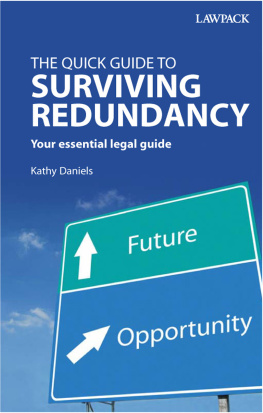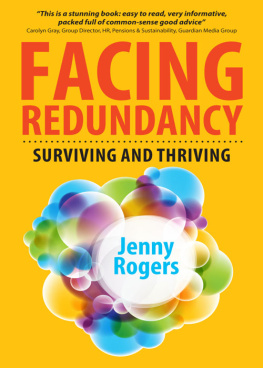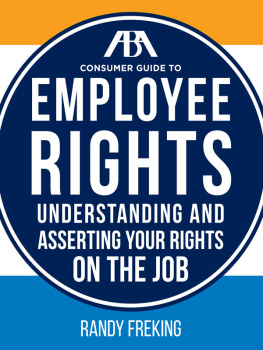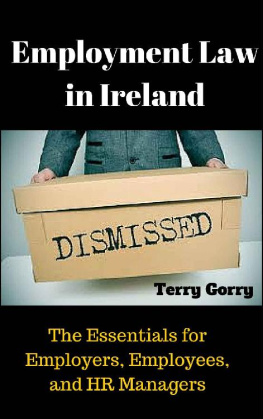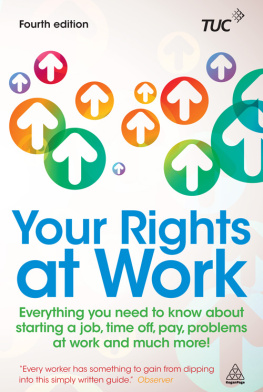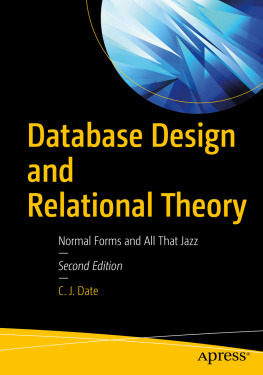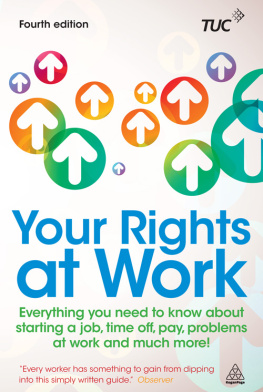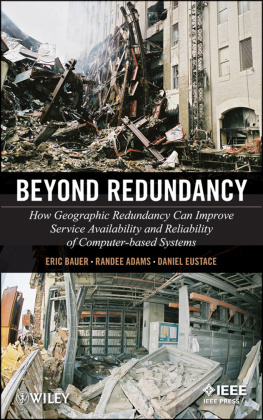
LAWPACK
THE QUICK GUIDE TO
SURVIVING REDUNDANCY
Kathy Daniels
Lawpack Publishing Limited
7689 Alscot Road
London SE1 3AW
www.lawpack.co.uk
All rights reserved
ISBN: 978-1-906971-40-3
2010 Lawpack Publishing Limited
This Lawpack Guide may not be reproduced in whole or in part in any form without written permission from the publisher.
The law is stated as at 1 January 2010
This guide is valid under the laws of England & Wales. Much of this legislation is mirrored exactly in Scotland and Northern Ireland, but readers should be aware that some practices may vary there, particularly relating to the names of tribunals and to benefits.
Exclusion of liability and disclaimer
While every effort has been made to ensure that this Lawpack publication provides accurate and expert guidance, it is impossible to predict all the circumstances in which it may be used. Accordingly, neither the publisher, author, retailer nor any other suppliers shall be liable to any person or entity with respect to any loss or damage caused or alleged to be caused by the information contained in or omitted from this Lawpack publication.
For convenience (and for no other reason) him, he and his have been used throughout and should be read to include her, she and her.
About the author
For many years Kathy Daniels worked in Human Resource Management roles in the manufacturing industry. She then started up her own business providing consultancy, lecturing and writing services.
Kathy teaches at Aston Business School in employment law and employee relations. She also tutors and writes open learning material for ICS Ltd, a large distance learning organisation. She carries out a number of roles for the Chartered Institute of Personnel and Development, and has written a number of books for their publishing division. She is a lay member of the Employment Tribunal, sitting in Birmingham.
Introduction
Facing redundancy is a difficult situation for everyone. Even though employees might value the opportunity to take their life in a new direction, the change that is imposed on them can be very stressful. There is a lot to think about, and often there is not a long period of time to do that thinking.
This book has been written to support those people who are facing redundancy, and for those who have friends or family who have been affected and want to offer effective support.
The book starts by looking at the law. Redundancy has to be managed in certain ways for it to be lawful, and this can sometimes be very confusing for the employees who are caught up in the process. It is hoped that an explanation of the law will help employees to have a clearer understanding of what is happening and the timescales involved.
The book then moves on to think about the financial issues. This is an inevitable stress that accompanies redundancy, as people face a time with no income or a lesser income. We will work through the different issues that need to be considered, an explanation of redundancy payments and an overview of financial support that might be obtainable.
Although it can be difficult, an important part of facing redundancy is to think about the future. Hence, the book goes on to think about the options for the employee. This includes training and education as well as looking for alternative employment. As well as thinking about the opportunities that are available the book also takes time to think about the application and interview process.
Finally, we will think about some of the emotional responses associated with redundancy focusing in particular on stress.
Redundancy is a difficult time, but hopefully you will feel more able to manage the situation, or support others facing redundancy, when you have read this book.
CHAPTER 1
What is redundancy?
When an organisation makes employees redundant it is essential that the law is carefully followed. The purpose of this chapter is to explain what legal processes an employer has to follow so that employees can understand what is happening in a redundancy situation.
Definition
The first important question is whether the situation really is a genuine redundancy. A redundancy happens in one of three situations:
The employer has stopped, or intends to stop, doing the work that the employee is employed to do.
For example, organisation A makes washing machines and refrigerators. The organisation decides to stop making washing machines, but carry on making refrigerators. The employees who make washing machines will be made redundant.
Another example could be organisation B that makes springs for the automotive industry. Organisation B decides that it is no longer going to make springs, and it is going to close the business. In this case all employees would be made redundant.
The organisation has stopped, or intends to stop, operating in the place where the employee works.
For example, organisation C has two call centres. One is in Bristol and one is in Birmingham. A decision is made to close the call centre in Bristol. In that case all the employees working in the Bristol call centre would be made redundant.
If the organisation had two call centres very close together, then it might be appropriate for the organisation to select the redundancies from across both locations even if only one was going to close. We will look at this in more detail in , under Selection.
The requirement for the organisation to do work of a particular kind, or to do work of a particular kind in a particular location, has (or is expected to have) diminished.
For example, organisation D is a large retail store. Over recent months there have been fewer customers, and sales have reduced. There is less work for the Sales Assistants to do and hence some of them are made redundant.
What does the organisation do when there is a redundancy situation?
If one of the three situations explained has occurred, or the organisation can see that it is about to occur, the organisation might decide that there is a need to make employees redundant.
At the initial stages the organisation will need to work out how many employees will be made redundant. If a whole site is closing, this might be everyone, but there might be the need to phase the closure of a site and hence the redundancies might be phased.
If the work has diminished, giving rise to the need for redundancies, then the organisation has to work out how many employees it now needs and calculate the redundancies accordingly.
As soon as the organisation has worked out that there do need to be redundancies there has to be consultation.
CHAPTER 2
Consultation
There are two types of consultation collective and individual. If there are more than 20 employees being made redundant, then there must be a period of collective consultation. If there are 20 or fewer employees being made redundant, then no collective consultation is required. (Individual consultation is dealt with in .)
If the situation will result in more than 20, but fewer than 100, employees being made redundant, then there will need to be a period of consultation that lasts for at least 30 days.
If the situation will result in 100 or more employees being made redundant, then there will need to be a period of consultation that lasts for at least 90 days.
Collective consultation is carried out with representatives of the employees.
Representatives
If the organisation recognises a trade union, then it will be usual for the consultation to take place with the trade union representatives.
Next page
